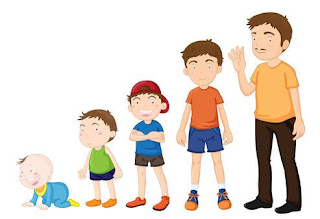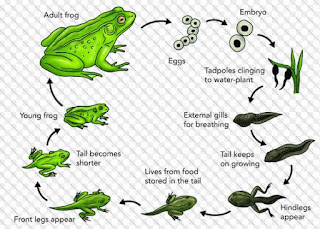Growth and development are the two processes running parallel and side by side. So the process of growth and development cannot be separated with one another. Every living being undergoes a process of growth and development.For example happens to ourselves, if the observed circumstances when the baby is very different from the current state.
Growth is a process of increasing the size of the cannot return to the origin (irreversible), which includes the expansion of the volume of the added mass of the dam. In addition to increasing the size of the cell, induced growth also occurred due to an increase in the number of cells.
Development is a process towards the achievement of a maturity. At the level of cellular differentiation, development can be either new cells divide to form specific organs that make up the network. In plants, the development marked by flowers or fruit. In animals and humans are characterized by the maturity of reproductive organs so that it is ready to produce offspring. The development also led to the development of the psychic from the age of infants, children, and becoming an adult.

Factors affecting growth and development
Factors affecting growth and development can be distinguished from factors within and from outside the body.1. Internal factors
Factors in affecting growth and development come from within the body of the living thing alone. That includes this category is a factor gene and hormonal State.
a. Genes
The gene is the substance/material derived from the nature of the carrier's parent. Genes influence characteristics of living things, such as body shape, height, skin color, the color of the flowers, the color of feathers, fruit flavors, and so on. Genes also determine the ability of the metabolism of living beings, thus affecting the growth and development. Animals, plants, and human beings who have the genes to grow good will grow and grow quickly in accordance with the periods of growth and development.
b. Hormones
A hormone is a substance that acts to control various functions in the body. Although the hormone simply applied a little, give a real influence in the setting of various processes in the body. Hormones that influence growth and development on a variety of types of living things.
1) Hormone in plants
Hormones in plants are often called fitohormon or substances regulatory body. Some of these are cytokinin, Auxin, ethylene, challenged, and abscisic acid.
a) Auxin serves to stimulate cell renewal, stimulates the formation of flowers, fruit, and enable cambium to form new cells.
b) Cytokinin, spur cell division and accelerate the formation of roots and shoots.
c) Challenged, stimulates the cleavage and cell enlargement as well as stimulate seed germination. On certain plants, challenged can lead to the emergence of the flower more quickly.
d) Ethylene acts to inhibit the lengthening of the stem, accelerate aging of fruit, and cause aging of leaves.
e) absitat Acid plays a role in the process of threshing leaves.
2) Hormones in animals
Some of the growth hormones in animals are as follows.
a) Thyroxine, controlling the growth of the animals. This hormone stimulates the frog at the start of the process of metamorphosis.
b), affect bone growth.
c) Ekdison and juvenil, influenced the development of phase larvae and adult phase, especially in the invertebrate.
3) Hormone in humans
Hormones are produced by the endocrine glands or blind, a channel that has no glands. Some human growth hormone among others as follows.
a. thyroxine Hormone, produced by the pituitary gland/thyroid goiter. This hormone affects growth, development, and metabolism of carbohydrates in the body. A deficiency of this hormone can lead to myxoedema that is overweight.
b) growth hormones (GH). This hormone is produced by the pituitary the front. These hormones are also called hormone somatotropin (STH). Its role is to influence the speed of growth of a person. A child will not grow up with normal growth hormone deficiency. During growth, the excess of this hormone will result in a giant growth (Gigantism), otherwise if the shortage will cause a dwarf (cretinism). If the excess hormone occurs after adulthood, will cause an increase in certain parts of the body, such as in the nose or ear. This disorder is called acromegaly.
c) hormone testosterone, regulate the development of reproductive organs and the emergence of signs of secondary sex in men.
the hormone estrogen) d/progesterone, set up the development of reproductive organs and the emergence of secondary signs of sex in women.
2. External Factors
External factors that affect the process of growth and development of living things comes from environmental factors. Some of the environmental factors that affect the growth and development of the living creature were as follows.
Food or nutrition
The food was raw materials and sources of energy in the body's metabolic processes. The quality and quantity of food affect the growth and development of living things. Because it is in its infancy, you should eat foods that are nutritious enough to support the growth and development of your body.
Nutrients needed human and the animal is carbohydrates, proteins, fats, vitamins, and minerals. All of these substances are obtained from food. As for plants, nutrients are needed in the form of water and nutrient substances that are dissolved in the water. Through the process of photosynthesis, water and carbon dioxide (CO2) is converted into food substances with the help of sunlight. Although not a direct role in photosynthesis, the nutrient substance required for the plants can grow and thrive.
Temperature
All living things need a temperature appropriate to support growth and development. This temperature is called the optimum temperature, for example, a normal human body temperature is around 37 ° C. At the optimum temperature, all living things can grow and thrive. Animals and humans have the ability to survive in a particular environment temperature range. Plants showed a more tangible influence against temperature.
Rice planted at the beginning of the dry season (average air temperature high) faster than the harvested rice grown in the rainy season (average temperature is low). Types of roses that grow and bloom well in a cool mountain, when planted in coastal areas are hot growth to be slow and do not produce flowers as beautiful as before. This is because all processes in the growth and development such as the water absorption, photosynthesis, respiration and evaporation, plants are affected by temperature.
3. The light
Light effect on the growth and development of living things. Plants really need sunlight for photosynthesis. But the presence of light turns out to be inhibiting the growth of plants because the light can damage the hormone Auxin found on the tip of the rod. When you save the sprouts in a dark place for a few days, that sprouts will grow faster (higher) than it should be, but looking weak and pale yellowish/for lack of chlorophyll. In addition to plants, humans also need sunlight to help the formation of vitamin D.
4. Water and Humidity
Water and humidity is an important factor for growth and development. Water desperately needed by living beings. Without water, living creatures cannot survive. The water is where the chemical reactions in the body. Without water, chemical reactions in the cell cannot take place so it can result in death.
Humidity is the abundance of water vapor content in the air or on the ground. Moist soil affects plant growth well against. Humid conditions a lot of water that can be absorbed by plants and less evaporation. These conditions greatly influence once against cell lengthening. Humidity is also critical to maintaining the stability of the shape of the cell.
5. Land
For plants, soil influence on growth and development. Plants will grow and grow with optimum when soil conditions place her life in accordance with the needs of nutrients and nutrient elements. Soil conditions are determined by other environmental factors, such as temperature, mineral content, and water.
The Metamorphosis
Metamorphosis is the event of the change of body shape gradually, beginning from larva to adult. Metamorphosis can be distinguished into two, namely, a perfect metamorphosis and metamorphosis is not perfect.1. Perfect Metamorphosis
Perfect metamorphosis is characterized by the presence of a phase called a pupa or chrysalis. The form of the adult insect larvae with much different. Stages in the metamorphosis are perfect is as follows.

2. Metamorphosis is not perfect (Hemimetabola)
Locust Metamorphosis

Insects that undergo metamorphosis is not perfect, the shape of the new insects are hatching (nymph) is not much different from the form of the adult insect (image). The striking difference is the nymphs do not have wings. The wings will grow incrementally so as to resemble the adult form. In general the nymphs and adult insects have the same properties.